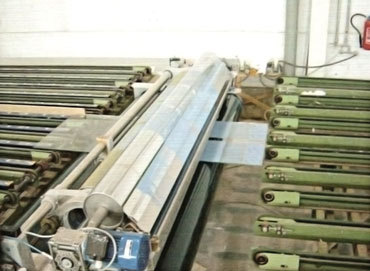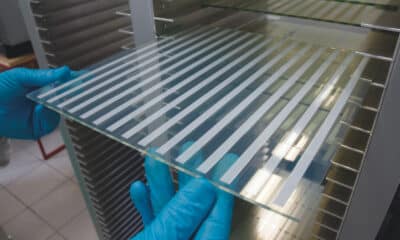Articles
Printing Tips for Today’s Fabrics
Published
7 years agoon

For the most part, today’s ready-for-use plastisol inks haven’t changed all that much over the years, other than the introduction of non-phthalate formulations. (There are, of course, newer non-PVC inks such as silicone, high-solids water based, and acrylic-based plastisol inks, though in this article I’ll be focusing on non-phthalate plastisols.) What has changed, though, are the types and styles of fabrics that printers are asked to decorate.
For the most part, today’s ready-for-use plastisol inks haven’t changed all that much over the years, other than the introduction of non-phthalate formulations. (There are, of course, newer non-PVC inks such as silicone, high-solids water based, and acrylic-based plastisol inks, though in this article I’ll be focusing on non-phthalate plastisols.) What has changed, though, are the types and styles of fabrics that printers are asked to decorate.
Over the last several years, the increased cost and lack of availability of cotton has, in part, pressured manufacturers to develop newer fabrics that can be – and often are – challenging to work with. One popular example is the lightweight performance wear that is great for exercising, constructed from a blend of several fibers that each adds its own benefit to the garment. For example, the fabric may be made up of Lycra, which adds stretch; cotton, which adds body; and polyester, which adds lightness and cost benefits.
Newer fabrics are often composed of a mix of synthetic and natural fibers, though they may also be made strictly from synthetics. It’s important to know what material you’re working with so you can choose an ink specifically formulated for it, whether it’s a 50/50 polyester/cotton blend or a performance fabric made from one or more synthetics.
Many of these engineered fabrics present distinct challenges to overcome. Let’s look at some of the more common ones printers encounter and how to resolve them.
AdvertisementBattling Dye Migration
 Inks formulated for 50/50 blends or 100-percent polyester fabric typically contain low-bleed ingredients to help reduce dye migration. Also known as bleeding or sublimation, dye migration is sometimes encountered with certain colors of polyester garments. It happens with polyester dyes that were heat-set (meaning cured or bonded) to the fibers at lower temperatures than what the shirts will be exposed to in curing standard plastisol inks. So, when you print these colored polyester fabrics and send them through a conveyor dryer at about 320 degrees Fahrenheit, the dyes are re-released (sublimated) and can turn a white ink design on a red garment into an unwanted pink. I’ve also seen instances where a dark blue or black fabric turned pink, not lighter shades of the base garment color as you would expect. (Left.) This phenomenon happens when a shirt that was first colored with a red dye is later over-dyed by the supplier with a darker color, possibly to reduce inventory.
Inks formulated for 50/50 blends or 100-percent polyester fabric typically contain low-bleed ingredients to help reduce dye migration. Also known as bleeding or sublimation, dye migration is sometimes encountered with certain colors of polyester garments. It happens with polyester dyes that were heat-set (meaning cured or bonded) to the fibers at lower temperatures than what the shirts will be exposed to in curing standard plastisol inks. So, when you print these colored polyester fabrics and send them through a conveyor dryer at about 320 degrees Fahrenheit, the dyes are re-released (sublimated) and can turn a white ink design on a red garment into an unwanted pink. I’ve also seen instances where a dark blue or black fabric turned pink, not lighter shades of the base garment color as you would expect. (Left.) This phenomenon happens when a shirt that was first colored with a red dye is later over-dyed by the supplier with a darker color, possibly to reduce inventory.
Some inks designed specifically for performance fabrics can be cured at lower temperatures (280 to 300 degrees  Fahrenheit) to further combat dye migration. However, some sublimated fabrics are prone to excessive bleeding even at the lower temperatures, leaving little that can be done to stop the white from turning into an unwanted color. This excessive dye migration is especially common with dye-sublimated polyester garments, often found in camouflage style prints. Bleed-blocking inks are now available that work not just by blocking the sublimating dye, but by actually absorbing it. (Right.) Typically, these blockers can also be cured at lower temperatures to help further contain the dye.
Fahrenheit) to further combat dye migration. However, some sublimated fabrics are prone to excessive bleeding even at the lower temperatures, leaving little that can be done to stop the white from turning into an unwanted color. This excessive dye migration is especially common with dye-sublimated polyester garments, often found in camouflage style prints. Bleed-blocking inks are now available that work not just by blocking the sublimating dye, but by actually absorbing it. (Right.) Typically, these blockers can also be cured at lower temperatures to help further contain the dye.
Giving Up the Ghost
As I mentioned above, it’s always important to use the right ink for the fabric you’re printing. Using low-bleed inks when they aren’t needed is a good example of what can go wrong. If you print them on 100-percent cotton and some 50/50 fabrics, you can encounter a phenomenon known as ghosting, where an image of the print may inadvertently transfer to the back of a garment stacked on top of it. This happens because the reactive dyes used for some cotton colors can react with the low-bleed bleaching agents in the ink. The ink coming off the dryer is still hot and reactive, the moisture from the shirt may not have completely evaporated, and the stacking creates a hot, humid environment – perfect for the ink to react with the dye in the shirt stacked on top, thus creating an unwanted “ghost” image of the print. If you have a short dryer outfeed or you’re running at a fast belt speed, you may be more likely to see this problem.
Two tips: Be sure to cool each shirt completely before stacking or packing them. And instead of having just one stack of shirts at the end of the dryer, consider creating several to give the garments a chance to cool down before another goes on top.
Stretching for the Cure
 Inks for performance fabrics are usually formulated to be low-bleed, but may also have an added ingredient to improve their ability to stretch. (Left.) This is an important factor with these synthetic materials, which are often designed to stretch more than the cotton fabrics and blends with which many printers are more familiar. Just like the garment, the ink must be able not only to stretch, but also to return to its normal state afterward, a quality called memory. While it’s important to obtain a full cure, as with any plastisol, be careful not to overheat inks printed on highly stretchable fabrics. This tends to make the ink film more brittle than normal and detract from its durability and stretch properties.
Inks for performance fabrics are usually formulated to be low-bleed, but may also have an added ingredient to improve their ability to stretch. (Left.) This is an important factor with these synthetic materials, which are often designed to stretch more than the cotton fabrics and blends with which many printers are more familiar. Just like the garment, the ink must be able not only to stretch, but also to return to its normal state afterward, a quality called memory. While it’s important to obtain a full cure, as with any plastisol, be careful not to overheat inks printed on highly stretchable fabrics. This tends to make the ink film more brittle than normal and detract from its durability and stretch properties.
Garment Considerations
Typical plastisol inks cure between 315 and 330 degrees Fahrenheit, which isn’t a problem when printing on cotton substrates. With synthetic performance fabrics, however, such temperatures might be an issue. Beyond dye migration, the garments may even shrink or become deformed. A low-cure additive will allow you to reduce the curing temperature to around 280 degrees Fahrenheit to give you some breathing room.
Always test a garment before a full production run, first to make sure an unfamiliar fabric can withstand the curing temperature, but also to ascertain that the ink is fully cured. A wash test is an ideal indicator of how well the ink is cured. Under-cured ink will wash off – if not entirely, then surely in several spots, most likely in the center of a design. In addition, the ink shouldn’t crack when the fabric is stretched. This could be a sign of under-curing, though with the newer low-cure inks for performance fabrics, it could be a sign that the curing temperature was too high.
Another type of print flaw might not be apparent to consumers until they try the garment on. Many of the newer fabrics being used today, especially for athletic wear, can’t hold up the weight of a standard print like the old cotton standbys. Some garments are so light that even a small print can make the decoration hang or drape stiffly. For these garments, use finer meshes with higher quality inks to reduce the weight of the ink deposit. This makes the design not only look better, but also feel more comfortable when worn.
Heavier garments, on the other hand, may be more prone to a defect known as fibrillation, in which yarn fibers from below the ink surface come through the ink film after washing, making the print appear fuzzy. Certain types of yarn, notably 100-percent cotton but also 100-percent acrylic and acrylic/cotton blends, are more prone to fibrillation than others. The best way to control it is to make sure the ink is fully cured and consider using a slightly coarser mesh count to deposit more ink. Using a matte-down screen after flashing the underbase will also help keep the fibers down and the surface of the print smooth.
Work uniforms present different considerations. More companies today have their logos or slogans screen-printed onto their uniforms rather than embroidered – a nice source of new business for some shops. However, uniforms must withstand an industrial washing process that is far more aggressive than what a standard consumer garment requires. Using a nylon-style catalyst when printing uniforms can dramatically improve the durability of the ink deposit, enabling it to withstand many industrial washes.
Garments with irregular or bumpy surfaces, such as zippers and hoodies, pose unique challenges when these features must be printed over. Often, printers have to improvise a solution in order to get the job done, and it may mean creating a custom platen that conforms to the irregular surface. I once made a platen out of quarter-inch aluminum to fit bobby socks so I could print designs like poodles and dice on the cuffs. Some strategically placed cardboard may also help minimize the bump caused by zippers and buttons.
Finally, fabrics designed to hold up in outdoor conditions can be problematic. Typically, printers use catalysts to help bond the ink to nylon fabrics, but many don’t know that catalysts can also help with especially difficult substrates such as certain polyester outerwear materials and the synthetics used for backpacks. Test it when you’re dealing with a problem fabric to see if it works. Another tip when you’re working with water-repellent fabrics: Try dabbing a little rubbing alcohol over the area to be printed. This may remove some of the water-repellent coating so that the ink with the catalyst can better adhere to the garment.
AdvertisementTest, Test, Test
Here is my motto for delivering the best possible outcome for your customer: Thoroughly test all prints and shirts before committing to costs and production methods. Never relax and assume that everything will run like the last time, even for a repeat job. A printer once told me that their customer supplied them with the same nylon jackets as a previous order, yet this time the jackets bled through the white print. What the customer did not tell them was that they had switched manufacturers, so instead of printing nylon again, the shop was dealing with a dyed polyester fabric. That turned out to be a costly mistake, as the bleeding was not discovered until several days after they had completed the job.
Everyone is looking out for themselves and you should be no different. A good customer will understand and appreciate your caution. They may even refer you to others because your service stands out.
Check out the rest of our October/November 2016 issue.

SPONSORED VIDEO
Let’s Talk About It
Creating a More Diverse and Inclusive Screen Printing Industry
LET’S TALK About It: Part 3 discusses how four screen printers have employed people with disabilities, why you should consider doing the same, the resources that are available, and more. Watch the live webinar, held August 16, moderated by Adrienne Palmer, editor-in-chief, Screen Printing magazine, with panelists Ali Banholzer, Amber Massey, Ryan Moor, and Jed Seifert. The multi-part series is hosted exclusively by ROQ.US and U.N.I.T.E Together. Let’s Talk About It: Part 1 focused on Black, female screen printers and can be watched here; Part 2 focused on the LGBTQ+ community and can be watched here.
You may like
Advertisement

Inkcups Announces New CEO and Leadership Restructure

Hope Harbor to Receive Donation from BlueCotton’s 2024 Mary Ruth King Award Recipient

Livin’ the High Life
Advertisement
Subscribe

Bulletins
Get the most important news and business ideas from Screen Printing magazine's news bulletin.
Advertisement
Most Popular
-

 Case Studies2 months ago
Case Studies2 months agoHigh-Density Inks Help Specialty Printing Take Center Stage
-

 Art, Ad, or Alchemy2 months ago
Art, Ad, or Alchemy2 months agoF&I Printing Is Everywhere!
-

 Andy MacDougall2 months ago
Andy MacDougall2 months agoFunctional and Industrial Printing is EVERYWHERE!
-

 Columns3 weeks ago
Columns3 weeks ago8 Marketing Mistakes Not to Make When Promoting Your Screen Printing Services Online
-

 Editor's Note2 weeks ago
Editor's Note2 weeks agoLivin’ the High Life
-

 Thomas Trimingham2 months ago
Thomas Trimingham2 months ago“Magic” Marketing for Screen Printing Shops
-

 Marshall Atkinson2 weeks ago
Marshall Atkinson2 weeks agoHow to Create a Winning Culture in Your Screen-Printing Business
-

 News & Trends1 month ago
News & Trends1 month agoWhat Are ZALPHAS and How Can You Serve Them in Your Print Business?












